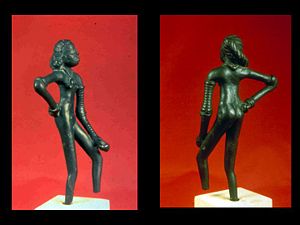The name of Mohenjo-daro is widely recognized as one of the most important early cities of South Asia and the Indus Civilization and yet most publications rarely provide more than a cursory overview of this important site.
Mohenjo-daro (Urdu: موئن جودڑو, Sindhi: موئن جو دڙو, English: Mound of the dead)—a city of the Indus Valley Civilization built around 2600 B.C.E., located in the Sindh Province of Pakistan. That ancient 5,000–year–old city constitutes the largest of Indus Valley, widely recognized as one of the most important early cities of South Asia and the Indus Valley Civilization. Mohenjo Daro, one of the world’s first cities and contemporaneous with ancient Egyptian and Mesopotamian civilizations, has been sometimes referred to as "An Ancient Indus Valley Metropolis."
Discovery and Major Excavations
Mohenjo Daro, built around 2600, had been abandoned around 1700 B.C.E..
Sir John Marshall's
archaeologists rediscovered it in the 1920s. His car, still in the Mohenjo-daro museum, shows his presence, struggle, and dedication for Mohenjo-daro.
Ahmad Hasan Dani and
Mortimer Wheeler carried out further excavations in 1945. Mohenjo-daro in ancient times had been most likely the administrative center of the ancient
Indus Valley Civilization. The most developed and advanced city in South Asia during its peak, Mohenjo-daro's planning and engineering showed the importance of the city to the people of the Indus valley.

Well at Mohenjo Daro
History: The Mohenjo-daro ruins had been once the center of this ancient society. At its peak, some archaeologists opine that the Indus Civilization may have had a population of well over five million. To date, over 1,000 cities and settlements have been found, mainly in the Indus River valley in Pakistan and north western India. Anthropologists have yet to decipher the language of the Indus Civilization, and the real name of the city as of other excavated cities in Sindh, Punjab and Gujarat, remains unknown. Mohenjo-Daro, 25 km southwest of Larkana, had been the center of the Indus Valley Civilization 2600 B.C.E.-1700 B.C.E.
Mohenjo-daro had been a remarkable construction, considering its antiquity. It has a planned layout based on a grid of streets, laid out in perfect patterns. At its height the city probably had around 35,000 residents. The buildings of the city, of particularly advanced designed, had structures constructed of same-sized sun dried bricks of baked mud and burned wood. The public buildings of those cities also suggest a high degree of social organization.

Covered Drain emptying down slope on major street leading to the Great Bath.
The great granary at Mohenjo-daro, designed with bays, received carts delivering crops from the countryside. Ducts exist for air to circulate beneath the stored grain to dry it. Close to the granary, a building similarly civic in nature stands: a great public bath, with steps down to a brick-lined pool in a colonnaded courtyard. The elaborate bath area had been extremely well built, with a layer of natural tar to keep it from leaking, and in the center stood the pool. Measuring 12m x 7m, with a depth of 2.4m, the pool had been likely used for religious or spiritual ceremonies.

Looking north along First Street. The area to the left has been fully excavated and the area to the right is unexcavated. Later street levels are seen in the background.
The houses had been designed and constructed to protect inhabitants from noise, odors, and thieves. That urban plan included the world's first urban sanitation systems. Within the city, individual homes or groups of homes obtained water from wells. Some of the houses included rooms that appear to have been set aside for bathing, waste water diverted to covered drains, which lined the major streets. Houses opened only to inner courtyards and smaller lanes. A variety of buildings stood up to two stories high. Being an agricultural city, it featured a large well, and central marketplace. It had a building with an underground furnace (hypocaust), possibly for heated bathing.

view of the city
 Sewage system used in Mohen jo daro
Sewage system used in Mohen jo daro
Artifacts

"The Dancing girl" artifact found in Mohenjo Daro”

A clay toy from Mohenjodaro
The Dancing girl found in Mohenjo Daro constitutes an interesting artifact some 4500-years old. The 10.8 cm long bronze statue of the dancing girl, found in 1926 from a house in Mohenjo Daro, had been British archaeologist Mortimer Wheeler's favorite statuette, as he said in this quote from a 1973 television program:
- "There is her little Baluchi-style face with pouting lips and insolent look in the eye. She's about fifteen years old I should think, not more, but she stands there with bangles all the way up her arm and nothing else on. A girl perfectly, for the moment, perfectly confident of herself and the world. There's nothing like her, I think, in the world."


![Reblog this post [with Zemanta]](http://img.zemanta.com/reblog_a.png?x-id=bea0a7e0-7a6e-447c-a9e0-32de4f114ebd)





















 Sewage system used in Mohen jo daro
Sewage system used in Mohen jo daro

![Reblog this post [with Zemanta]](http://img.zemanta.com/reblog_e.png?x-id=b1cd0809-0a1f-470f-940d-02b545a33808)















